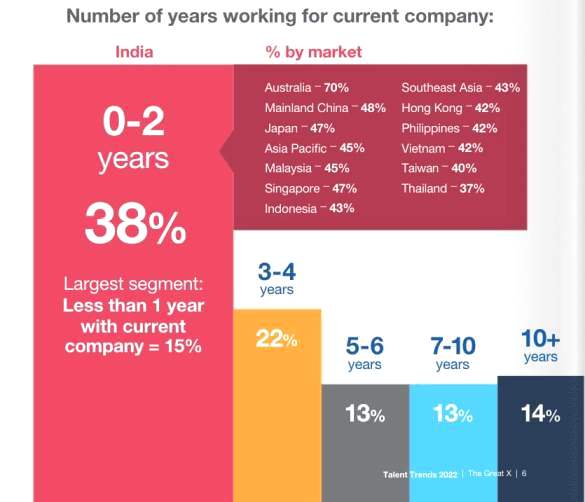
All organizations, from thriving start-ups to large corporations, are deeply concerned about the attrition that they are facing. While we continue to get adjusted to the new normal, a new study, The Great X by Michael Page found that 86% of employees in India plan to resign within the next 6 months. The Great Resignation is a term we have seen a lot in the last few months, but what does it mean? Anthony Klotz, an organizational psychologist at Texas A&M University, coined the term: The Great Resignation, to describe the wave of people quitting their jobs as a result of the ongoing pandemic.
There will be a high attrition rate in almost every industry, led by Manufacturing, Travel, and Retail followed by FMCG, Technology, and Insurance among the highest ever. As a result, experts predict that the Great Resignation will continue in 2022 in India, and in the next 6 months, 92% to 84% in the above-mentioned industries plan to resign. Even more surprising is that the great resignation era in India will be led by those who have been in their current jobs for less than two years.

While 86% of the participants in The Great X report will be looking for new career prospects in the next 6 months, managers will top the charts at 89%. Employees in India are willing to accept lower compensation or slow promotions to improve their work-life balance and not ready to compromise this for a better pay package, irrespective of the level of experience or age. Needless to say, to deal with this growing trend, organizations must prepare for “a significant talent migration event,” which is not far away as some organizations are already experiencing it.
According to the same report, only 11% of employees who have resigned or plan to resign cite Covid regulations as the reason. The root causes of the rising number of employees quitting their jobs are career advancement or promotion or change in career or industry followed by dissatisfaction with compensation. Most people leave their jobs, about 48%, because they want to advance in their careers. Employee well-being and happiness have overtaken pay and perks as the most important considerations. Organizational work cultures (hybrid, home-based, etc.) have recently been the subject of much debate.
Are the Employees Just Walking Away?
According to Ian Cook’s Harvard Business Review research of the Great Resignation, mid-level employees have been driving the spike in resignations. So why is this the case?
- After months of heavy workloads, hiring freezes, and other pressures, employees hit a breaking point. About 57% of employees cited their workload has increased post-COVID and 52% say their stress levels
- Employers have realized that hiring people with minimal experience, onboarding them, and training them remotely is riskier and as a result mid-career workers were in high demand
Pandemic has prompted people to rethink the role of work in their lives because of the large number of deaths and serious illnesses. Particularly, those who became overburdened with work that interfered with their ability to provide for their families. Women and younger age groups have been more affected than older ones.
Approximately one-third of working women are considering quitting their jobs, making a career change, or reducing their hours, according to the Women in the Workplace report from 2021.
The Great Retention
Many job seekers already have and are reevaluating their priorities due to the COVID-19 pandemic. People are open to and are relocating to new fields and roles more aligned with their values and aspirations. Employers prefer to deal with folks who want to help grow our business rather than those who feel stifled or are unable to do so. As a result, these conventional queries of “Why do you want to work with us?” and the likes of it, now hold more weight than ever when you’re interviewing a potential employee for a role.
There is a sense of fatigue, current jobs are stressful, the market is open, people are shopping for multiple offers and they want to move forward in their careers instead of doing the same thing daily. So, what can companies do to survive The Great Resignation and have an edge over the others in keeping their employees on board?
Loyalty and Rewards
Keeping employees in 2022 does not mean only paying them well, it is the overall package that will keep them loyal. Implementing an attractive bonus structure for performance, loyalty, innovation etc. in addition to improving your company’s current compensation package. Consider providing a competitive time-bound financial assistance for higher education or helping the recipient save money to use as a down payment for a home or a vehicle purchase.
Like Max Life has a Scholars policy for employees who want to pursue higher education. A better flexible benefits structure that helps them save tax. The opportunity to correct any pay inequalities occurring due to gender, PwD etc. to be provided when compensation is reset. Activating the alumni network & evaluating the proposition to initiate a long-term relationship with them. Paid time off for employees if they or their families get exposed to COVID-19, are some of the ideas that can win the loyalty of the employees.
Understand Their Word & Act on It
“Listening Posts” or consulting with employees to get a sense of their general well-being and attitude towards productivity and rewards expectations. This data can come in handy to develop your company’s compensation plans and should be used to focus on the areas where they most need assistance. Listening to the employees will not only allow you to provide better benefits and compensation plans, but it will also allow you to improve the quality of your workplace.
Having said that listening needs to be followed by action and updates. Organizations tend to conduct employee surveys, however, no or little action is initiated. When you close the loop and act on the feedback from the employees, they know you care. For example, Nestle followed a process of evaluating each job role to see if the role is required to be in the office or can work remotely. Allow your employees to skip the tedious process of clocking in and out of the office.
When formulating strategies, keep in mind what employees have to say and what you can do to meet their varying requirements. Be sure to give employees a voice in the decision-making process.
Room to Grow and Thrive
Imagine for a moment that your best employees have just informed you that they are resigning. Would you know how to keep them from leaving?
Consider the importance of employee retention right from when you are hiring the candidate or doing the performance reviews, and ask about their ideal job and consider how you can fill these kinds of jobs for them.
In the last few months, almost all the organizations have conducted retention interviews to find out what will help people to stay with their current company. People often leave jobs because they don’t feel that their abilities are being put to good use. What do you do? How do you keep your employees happy and productive?
The simple answer is to increase the opportunities basis the employee aspirations and provide them with the chance to broaden their skill set. Sharpening the current skills and learning new ones is a priority for employees and a clear expectation from employers.
Hybrid and Remote-friendly is Mandatory to be “A cool place to work”
Even before the emergence of the pandemic, a majority of knowledge workers expressed a desire to work from home and were willing to give up their jobs to do so. While some organizations had remote working as a part of the culture, a lot were still pondering on it, and would have taken years to make the transition.
The pandemic expedited the same and all were working remotely in a matter of few days. But as things start to go back to normal, we realize this is a difficult pill to take. Moreover, not all businesses can afford to have a remote or even a blended workforce. Some businesses must have face-to-face interactions, however, let’s face it: not all need to.
While I was working with Sapient Consulting (2008-2014), one of my colleagues was based out of Korea for 2 years, which was a brave decision as there was no office in Korea. We all have realized that many things that we thought were impossible turned out to be feasible.
So, let’s take some time to reflect on this and management should ponder this before making any decisions against a hybrid or remote workplace.
Are We Panicking?
Many recruiters and HR people tend to panic about hiring under the pressure to fill many open positions in a short period. A bad hire is likely to cost the organization financially and culturally in the long term. Hence, while finalizing the candidate make sure, you think about:
- Candidate’s values are in alignment with that of organization’s
- Apart from the designation & compensation, what motivates the candidate to work with the organization
- Candidate’s ability to grow with the organization
The Great Resignation didn’t just happen as a result of the pandemic. Business leaders will benefit from identifying the specific causes of employee turnover and devising strategies to combat it. That’s why futuristic companies, need to think of how to enable their employees. Benefits tailored to employees’ evolving needs will be a key differentiator for companies competing for top talent.
Employers who demonstrate a long-term focus on employee development, and cross-functional skills by offering training and other opportunities will gain greater loyalty and reputation with prospective employees. The factors that sparked the Great Resignation were not one-offs; they are here to stay.
Remote is the preference of the employees however, this also needs to be tread carefully. Clearly defined responsibilities, outcome-based performance reviews, and employee-friendly policies will lead the way for remote workers. Without them, we’re putting remote teams at a significant disadvantage. This is why it is critical to invest in a culture that fosters trust and ownership in the future.
Async work, something that GE Capital (now Genpact) had been following for years now. It allows employees to work when it’s most convenient for them, rather than adhering to a strict “log in/log off” timetable along with regular check-ins and reporting. It’s all based on the assumption that you have a team of trustworthy, highly devoted, and performance-oriented superstars.








